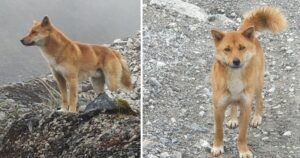
a small population of wild dogs discovered via research.
Unintended consequences frequently result from human intervention with the natural order of things. The rarest and most covert organisms are typically the ones who suffer harm as resources and land are depleted.
One of the animals could be the New Guinea wild dog.
The singing dog of New Guinea is a stunning animal to observe.
Given their distinctive ability to synchronize while howling, the singing dogs live up to their name. It’s scary and unsettling to hear one of these exceedingly uncommon creatures. The noise it makes when it lifts its head and howls sounds like it belongs in a scary movie.
Only 200 of the dogs remain in zoos and conservation facilities.
In reality, there are barely 200 or so remaining in captivity worldwide due to the dogs’ extreme rarity. A tiny group that was taken from the wild in the 1970s gave rise to all 200 animals that are currently in captivity.
Surprisingly, researchers believe they have located a people still residing in New Guinea’s Highlands!
While on a research expedition, researchers came upon a pack of wild dogs who resembled the confined dogs somewhat. In order to research and record 15 of the dogs, the team set off in 2016 for the highlands of Papua, Indonesia.
They returned in 2018 to do their more thorough study after discovering the pack.
They would need further information if these were the fabled singing dogs. Three of the dogs had blood samples taken from as well as a ton of behavioral and physiological information gathered by the researchers. To ascertain if these were in fact the unusual dogs, they required all the information they could collect.
The data was eventually published in a report after several years.
The gene sequences in the DNA of the domesticated animals and the DNA of wild canines are very similar! For comparison, the two have more in common than other canine DNA does.
If they are of the same breed, what could make their DNA differ?
It’s a good question, and the solution is right here. The straightforward explanation is that the caged canines are severely inbred, which reduces the size of their gene pool. Eight initial canines that were seized decades ago are the ancestors of all 200 dogs held hostage.
The canines used for conservation are extremely inbred, CNN cited Elaine Ostrander, a researcher at the National Institutes of Health and the paper’s principal author. “[It] began with eight canines, and they have been bred to each other, bred to each other, and bred to each other for generations – so they have lost a lot of genetic variation.”
The goal is to breed some of the captive dogs with the new wild ones!
Inbreeding can have detrimental effects on health, thus we need to take action if we want to preserve the rare and exquisite species. To diversify the gene pool and produce a healthier and more resilient captive population, the approach is to breed the two together.
We should work to preserve the uncommon and exotic New Guinea singing dogs.
These odd dogs deserve our protection because of their eerie and harmonising calls. The creatures in captivity now stand a chance!
Please SHARE this with your friends and family.